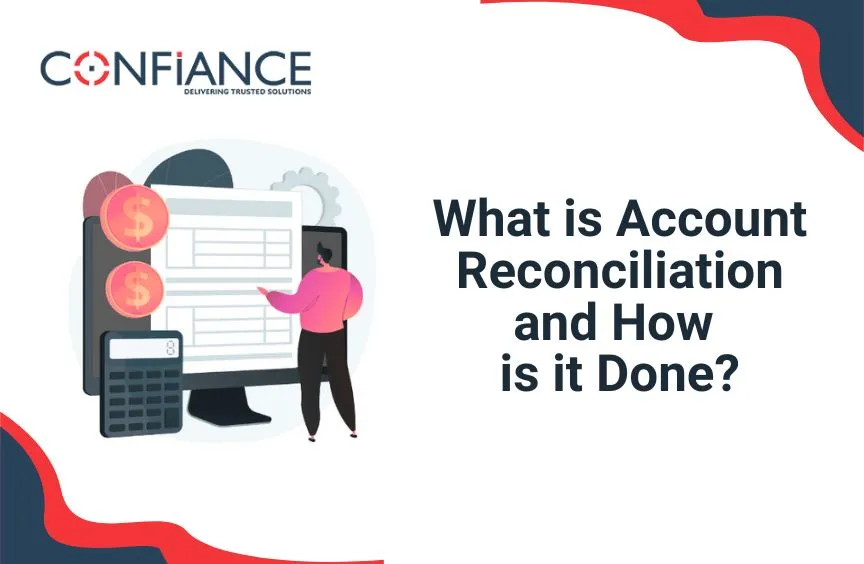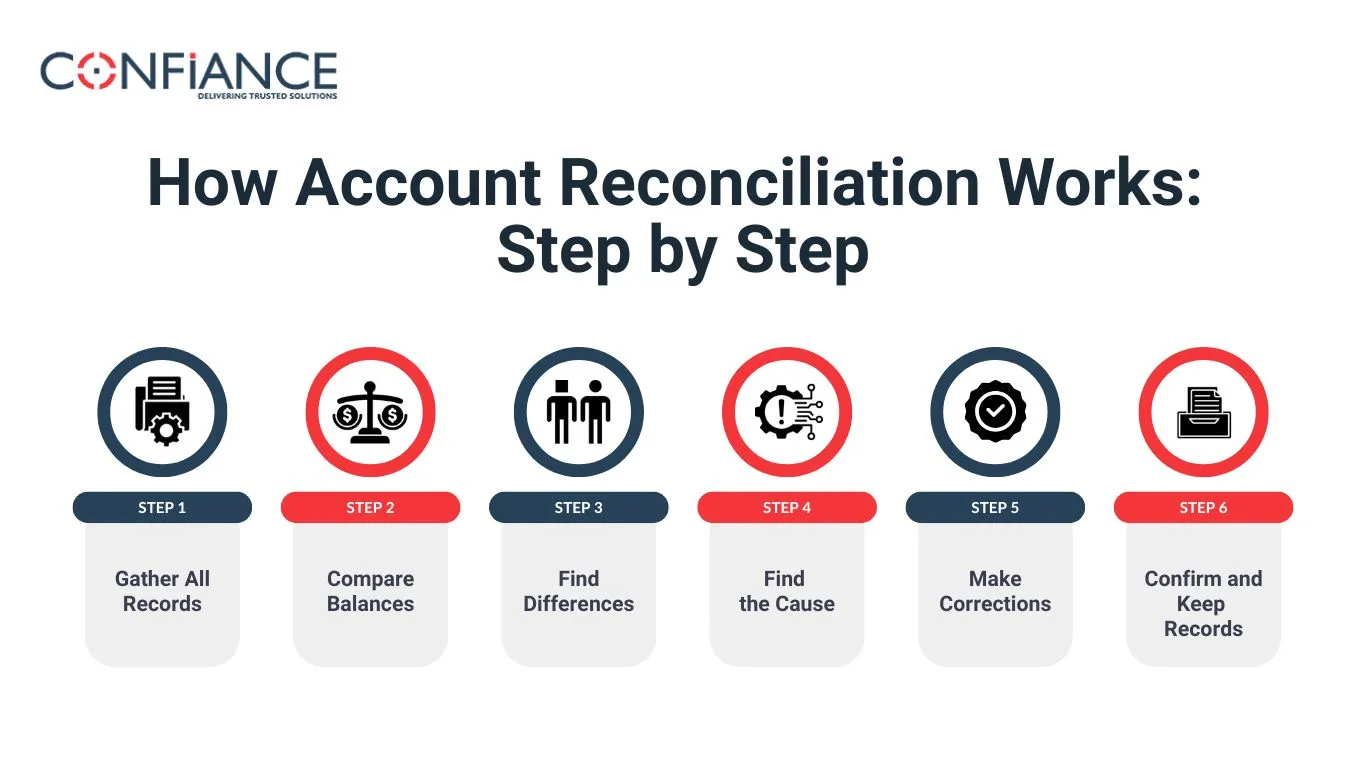
What is Account Reconciliation and How is it Done?
Account reconciliation is an essential part of managing finances. It means checking that the numbers in your records match those in outside documents. This is more than just looking at numbers. It is about making sure each transaction is correct and backed by proof.
Many people ask, what is account reconciliation and why is it important in accounting? Simply put, it is the act of comparing two sets of records. For example, a company’s bank ledger should match the bank’s statement. If they do not match, you must find the reason and fix it.
Accounting reconciliation helps keep records clean. It stops errors, missing entries, and false information. Without reconciliation, mistakes can hide and cause wrong decisions. In this blog, we will look at what account reconciliation is and how it is done.
Why Account Reconciliation Matters
Reconciliation has many key reasons:
Accuracy in Records
Having right and steady records is very important. They form the base for reports, tax returns, and decisions.
Fraud Detection
Matching records can show signs of wrong or fake transactions.
Following the Law
Many laws require keeping clear financial records. Reconciliation helps meet these rules.
Smooth Audits
Well-checked accounts are easier to review. Documents are ready, and numbers are clear.
Better Cash Control
When records match, a business sees its real cash situation.
When Should Reconciliation Be Done?
How often you do accounting reconciliation depends on your business size and transaction count. Many do it monthly when closing books. Others with more transactions do it weekly or daily. The goal is to keep differences small and simple to solve.
Common accounts to reconcile include:
- Bank accounts
- Credit card accounts
- Supplier accounts
- Customer accounts
- Payroll accounts
- Loan accounts
How Account Reconciliation Works: Step by Step
To understand what is account reconciliation, it helps to see the steps.
Step 1: Gather All Records
Start with full and correct data. Collect:
- Internal ledgers
- Bank or credit card statements
- Supplier statements
- Customer statements
- Loan statements
- Payroll reports
Step 2: Compare Balances
Look at the closing balance in your books and compare it to the outside statement. If they match, the account is reconciled. If not, note the gap.
Step 3: Find Differences
Differences happen for many reasons:
- Timing issues, like checks not cleared yet or deposits in transit
- Errors in entering data
- Missing transactions
- Double entries
- Bank fees or interest not recorded

Step 4: Find the Cause
You must trace each difference to its source. This means checking receipts, invoices, or payment records. The goal is to know why the numbers do not match.
Step 5: Make Corrections
Once you know the cause, record the needed changes. For example, add a bank fee if missed. Remove duplicate entries if found.
Step 6: Confirm and Keep Records
After changes, balances should match. Write down the reconciliation. Keep copies of statements, notes, and corrections. This helps for audits or reviews.
Common Types of Account Reconciliation
Reconciliation is not only for bank accounts. There are several types:
Bank Reconciliation
This compares your cash account to the bank statement. It helps spot wrong withdrawals, missing deposits, or bank errors.
Supplier Reconciliation
This matches supplier bills with your records. It makes sure all bills are logged and paid.
Customer Reconciliation
This compares customer balances with what they say. It helps clear up payment disputes.
Payroll Reconciliation
This checks payroll expenses with reports and payments. It confirms correct pay and tax records.
Credit Card Reconciliation
This compares credit card expenses in books with the card statement.
Loan Reconciliation
This matches loan balances with lender statements, including principal and interest.
Example of Account Reconciliation
Here is what is account reconciliation in practice:
A business shows $20,000 in its bank ledger at month’s end. The bank statement shows $19,700. The $300 difference is because:
- A bank fee of $50 is not recorded
- A check of $250 is still pending
The fee is added to the ledger. The check is noted as pending in the reconciliation. After this, records match.
Common Problems Found During Reconciliation
This process often finds:
- Missing invoices or receipts
- Bank fees not recorded
- Payments entered in wrong accounts
- Duplicate transactions
- Transactions in the wrong time period
- Unauthorized charges
Best Practices for Good Reconciliation
Good reconciliation needs care and habit. These tips help:
Keep Records Updated
Enter transactions quickly to avoid mix-ups.
Use Clear Descriptions
Write simple notes for each entry to make checks easier.
Use Accounting Software
Many systems pull bank data and match entries fast.
Set a Regular Schedule
Do reconciliation often to avoid big errors.
Keep Documents
Save statements, notes, and reports for checks.
Separate Duties
Have one person do reconciliation who does not handle cash to stop fraud.
Manual vs Automated Reconciliation
There are two ways to reconcile accounts.
Manual Reconciliation
- Use printed or digital statements
- Match each transaction by hand
- Takes more time
- Risk of mistakes
Automated Reconciliation
- Use software to match transactions
- Faster and more accurate
- Flags differences automatically
- Cuts staff workload
Automation suits businesses with many transactions. Manual checks still help find unusual entries.
How Technology Helps Reconciliation
Modern tools have made accounting reconciliation easier. Many connect to bank accounts and fetch data in real time. They match transactions, find errors, and suggest fixes.
Cloud software lets teams work together from different places. It also cuts down paper work.
Risks of Skipping Reconciliation
Not doing reconciliation can cause problems:
- Financial reports may be wrong
- Fraud may go unseen
- Balances may be wrong
- Supplier or customer disputes may rise
- Tax filings may have errors that lead to fines
How to Improve Reconciliation
To get better results:
- Train staff to spot and fix errors
- Use templates to keep work steady
- Check big transactions closely
- Act fast on unclear differences
- Use a checklist for each account type
Reconciliation in Small Businesses
Small businesses may skip reconciliation due to time. But regular checks help avoid fees, missed payments, and tax mistakes. It also shows true cash flow.
Reconciliation in Large Organizations
Big companies often have teams for accounting reconciliation. They use software and follow strict rules. This keeps data steady across many units.
Records for Audits
Clear reconciliation records are key for audits. Auditors want to see how numbers were checked. They look at:
- Bank statements
- Adjustments made
- Notes on differences
- Proof of transactions
Accurate records make audits faster and easier.
Knowing what is account reconciliation is the key to keeping correct financial records. Comparing your records to outside statements helps catch errors. Accounting reconciliation is more than law. It stops errors and fraud. It helps make good choices and keeps trust with partners. It shows the true financial state of the business.
Doing reconciliation regularly, whether manually or with software, protects any business. It keeps the books accurate, audits smooth, and the company stable. If you cannot manage reconciliation on your own, you can outsource it to experts. At Confiance, we offer complete reconciliation services that guarantee accuracy and reliability. You can contact us anytime for reconciliation of all types
FAQs
- What is account reconciliation in accounting?
Account reconciliation means checking your records against outside statements to make sure transactions are correct and backed by proof. - Why must businesses do account reconciliation regularly?
It keeps records accurate, helps find fraud, meets legal requirements, and makes audits easier. - How often should account reconciliation happen?
It depends on business size and transactions. Some do it daily, others weekly or monthly. - Which accounts usually need reconciliation?
Common accounts are bank, credit card, supplier, customer, payroll, and loan accounts. - What are the main steps in account reconciliation?
First, gather all records. Then compare balances, find differences, trace their cause, fix errors, and keep records. - What problems do businesses find during reconciliation?
They often find missing invoices, unrecorded fees, wrong entries, duplicate transactions, and timing mistakes. - How does software help with reconciliation?
It connects to bank data, matches transactions fast, flags errors, and lowers manual work. - What risks come from skipping reconciliation?
Skipping it can cause wrong reports, missed fraud, incorrect balances, disputes, and tax errors.
